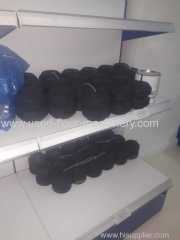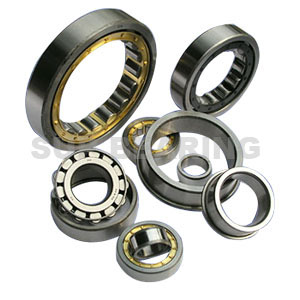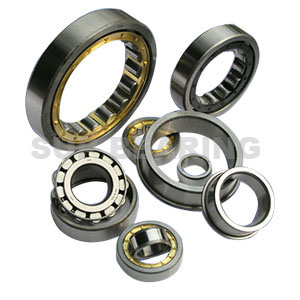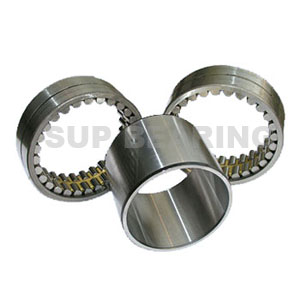.gif)
40RIT133 TORRINGTON BEARING
| Payment Terms: | T/T, L/C |
| Place of Origin: | Zhejiang, China (Mainland) |
|
|
|
| Add to My Favorites | |
| HiSupplier Escrow |
Product Detail
Model No.:
40RIT133
Production Capacity:
100
Delivery Date:
60~70
Means of Transport:
by sea ,by airplane
Packing:
smoked-free wooden box
Brand Name:
SUP OR NATURAL
Single row cylindrical roller bearings The rollers in a single row cylindrical roller bearings are always guided between the integral "open" flanges
Single row cylindrical roller bearings
The rollers in a single row cylindrical roller bearings are always guided between the integral "open" flanges on one of the rings. These "open" flanges combined with the specially designed and surface treated roller ends, provide improved lubrication, reduced friction and consequently lower operating temperature.
The ring with the integral flanges together with the cylindrical roller and cage assembly can be separated from the other ring. This results in easy mounting and dismounting, particularly where the load conditions are such that interference fits are required for both rings.
SUP BEARING single row cylindrical roller bearings can accommodate heavy radial loads and high speeds. They are manufactured in several different designs, the main difference being in the configuration of the flanges. The most popular are the NU, N, NJ and NUP designs.
NU design
The outer ring of bearings of the NU design has two integral flanges and the inner ring is without flanges. Axial displacement of the shaft with respect to the housing can be accommodated in both directions within the bearing itself. The bearings are therefore used as non-locating bearings. For manufacturing and maintenance reasons, the two outer ring flanges of large-size bearings of the NU design which are identified by a Drawing No. may not be integral but take the form of loose flange rings.
The outer ring of bearings of the NU design has two integral flanges and the inner ring is without flanges. Axial displacement of the shaft with respect to the housing can be accommodated in both directions within the bearing itself. The bearings are therefore used as non-locating bearings. For manufacturing and maintenance reasons, the two outer ring flanges of large-size bearings of the NU design which are identified by a Drawing No. may not be integral but take the form of loose flange rings.
N design
The inner ring has two integral flanges and the outer ring is without flanges). Axial displacement of the shaft with respect to the housing can be accommodated in both directions within the bearing itself. The bearings are therefore used as non-locating bearings.
The inner ring has two integral flanges and the outer ring is without flanges). Axial displacement of the shaft with respect to the housing can be accommodated in both directions within the bearing itself. The bearings are therefore used as non-locating bearings.
NJ design
The outer ring has two integral flanges and the inner ring one integral flange. The bearings are therefore suitable for the axial location of a shaft in one direction,
The outer ring has two integral flanges and the inner ring one integral flange. The bearings are therefore suitable for the axial location of a shaft in one direction,
NUP design
The outer ring has two integral flanges and the inner ring one integral flange and one non-integral flange in the form of a loose flange ring. The bearings can be used as locating bearings, i.e. they can provide axial location for a shaft in both directions,
The outer ring has two integral flanges and the inner ring one integral flange and one non-integral flange in the form of a loose flange ring. The bearings can be used as locating bearings, i.e. they can provide axial location for a shaft in both directions,
Didn't find what you're looking for?
Post Buying Lead or contact
HiSupplier Customer Service Center
for help!
Related Search
Find more related products in following catalogs on Hisupplier.com
Related Products
.gif)
Company Info
Ningbo SUP Bearing Co., Ltd. [China (Mainland)]
Business Type:Manufacturer, Trading Company, Distributor/Wholesaler, Service
City: Ningbo
Province/State: Zhejiang
Country/Region: China (Mainland)
You May Like:
Product (3941)
- Bearings for Oil Production & Drilling (14)
- Bearings for Concrete Mixer Gear Reducer (5)
- Spherical Roller Bearings (2)
- Taper roller bearings (2510)
- Slewing ring (42)
- Deep groove ball bearings (1)
- Cylindrical roller bearings (1043)
- Spherical roller thrust bearings (3)
- Taper roller thrust bearings (52)
- Cylindrical roller thrust bearings (204)
- Full complement cylindrical roller bearings (3)
- Auto bearings (9)
- Spherical plain bearings and rod ends (4)
- Angular contact ball bearings (3)
- Self-aligning ball bearings (1)
- Needle roller bearings (12)
- Miniature bearings (6)
- Bearing housings (6)
- Bearing units (5)
- Thrust roller bearings (3)
- Roller Bearings (11)
- Ball Bearings (2)







.jpg)
.jpg)
.jpg)
.jpg)
.jpg)
.jpg)
.jpg)
.jpg)
.jpg)
.jpg)
.jpg)
.jpg)
.jpg)
.jpg)
.jpg)
.jpg)
.jpg)
.jpg)
.jpg)
.jpg)
.jpg)
.jpg)
.jpg)
.jpg)
.jpg)
.jpg)
.jpg)
.jpg)
.jpg)
.jpg)
.jpg)
.jpg)
.jpg)
.jpg)
.jpg)
.jpg)
.jpg)
.jpg)
.jpg)
.jpg)
.jpg)
.jpg)
.jpg)
.jpg)
.jpg)
.jpg)
.jpg)
.jpg)
.jpg)
.jpg)
.jpg)
.jpg)
.jpg)
.jpg)
.jpg)
.jpg)
.jpg)
.jpg)
.jpg)
.jpg)
.jpg)
.jpg)
.jpg)
.jpg)
.jpg)
.jpg)
.jpg)
.jpg)
.jpg)
.jpg)
.jpg)
.jpg)
.jpg)
.jpg)
.jpg)
.jpg)
.jpg)
.jpg)
.jpg)
.jpg)
.jpg)
.jpg)
.jpg)
.jpg)
.jpg)
.jpg)
.jpg)
.jpg)
.jpg)
.jpg)
.jpg)
.jpg)
.jpg)
.jpg)
.jpg)
.jpg)
.jpg)
.jpg)
.jpg)
.jpg)
.jpg)
.jpg)
.jpg)
.jpg)
.jpg)
.jpg)
.jpg)
.jpg)
.jpg)
.jpg)
.jpg)
.jpg)
.jpg)
.jpg)
.jpg)
.jpg)
.jpg)
.jpg)
.jpg)
.jpg)
.jpg)
.jpg)
.jpg)
.jpg)
.jpg)
.jpg)
.jpg)
.jpg)
.jpg)
.jpg)
.jpg)
.jpg)
.jpg)
.jpg)
.jpg)
.jpg)
.jpg)
.jpg)
.jpg)
.jpg)
.jpg)
.jpg)
.jpg)
.jpg)
.jpg)
.jpg)
.jpg)
.jpg)
.jpg)
.jpg)
.jpg)
.jpg)
.jpg)
.jpg)
.jpg)
.jpg)
.jpg)
.jpg)
.jpg)
.jpg)
.jpg)
.jpg)
.jpg)
.jpg)
.jpg)
.jpg)
.jpg)
.jpg)
.jpg)
.jpg)
.jpg)
.jpg)
.jpg)
.jpg)
.jpg)
.jpg)
.jpg)
.jpg)
.jpg)
.jpg)
.jpg)
.jpg)
.jpg)
.jpg)
.jpg)
.jpg)
.jpg)
.jpg)
.jpg)
.jpg)
.jpg)
.jpg)
.jpg)
.jpg)
.jpg)
.jpg)
.jpg)
.jpg)
.jpg)
.jpg)
.jpg)
.jpg)
.jpg)
.jpg)
.jpg)
.jpg)
.jpg)
.jpg)
.jpg)
.jpg)
.jpg)
.jpg)
.jpg)
.jpg)
.jpg)
.jpg)
.jpg)
.jpg)
.jpg)
.jpg)
.jpg)
.jpg)
.jpg)
.jpg)
.jpg)
.jpg)
.jpg)
.jpg)
.jpg)
.jpg)
.jpg)
.jpg)
.jpg)
.jpg)
.jpg)
.jpg)
.jpg)
.jpg)
.jpg)
.jpg)
.jpg)
.jpg)
.jpg)
.jpg)
.jpg)
.jpg)
.jpg)
.jpg)
.jpg)
.jpg)
.jpg)
.jpg)
.jpg)
.jpg)
.jpg)
.jpg)
.jpg)
.jpg)
.jpg)
.jpg)
.jpg)
.jpg)
.jpg)
.jpg)
.jpg)
.jpg)
.jpg)
.jpg)
.jpg)
.jpg)
.jpg)
.jpg)
.jpg)
.jpg)
.jpg)
.jpg)
.jpg)
.jpg)
.jpg)
.jpg)
.jpg)
.jpg)
.jpg)
.jpg)
.jpg)
.jpg)
.jpg)
.jpg)
.jpg)
.jpg)
.jpg)
.jpg)
.jpg)
.jpg)
.jpg)
.jpg)
.jpg)
.jpg)
.jpg)
.jpg)
.jpg)
.jpg)
.jpg)
.jpg)
.jpg)
.jpg)
.jpg)
.jpg)
.jpg)
.jpg)
.jpg)
.jpg)
.jpg)
.jpg)
.jpg)
.jpg)
.jpg)
.jpg)
.jpg)
.jpg)
.jpg)
.jpg)
.jpg)
.jpg)
.jpg)
.jpg)
.jpg)
.jpg)
.jpg)
.jpg)
.jpg)
.jpg)
.jpg)
.jpg)
.jpg)
.jpg)
.jpg)
.jpg)
.jpg)
.jpg)
.jpg)
.jpg)
.jpg)
.jpg)
.jpg)
.jpg)
.jpg)
.jpg)
.jpg)
.jpg)
.jpg)
.jpg)
.jpg)
.jpg)
.jpg)
.jpg)
.jpg)
.jpg)
.jpg)
.jpg)
.jpg)
.jpg)
.jpg)
.jpg)
.jpg)
.jpg)
.jpg)
.jpg)
.jpg)
.jpg)
.jpg)
.jpg)
.jpg)
.jpg)
.jpg)
.jpg)
.jpg)
.jpg)
.jpg)
.jpg)
.jpg)
.jpg)
.jpg)
.jpg)
.jpg)
.jpg)
.jpg)
.jpg)
.jpg)
.jpg)
.jpg)
.jpg)
.jpg)
.jpg)
.jpg)
.jpg)
.jpg)
.jpg)
.jpg)
.jpg)
.jpg)
.jpg)
.jpg)
.jpg)
.jpg)
.jpg)
.jpg)
.jpg)
.jpg)
.jpg)
.jpg)
.jpg)
.jpg)
.jpg)
.jpg)
.jpg)
.jpg)
.jpg)
.jpg)
.jpg)
.jpg)

